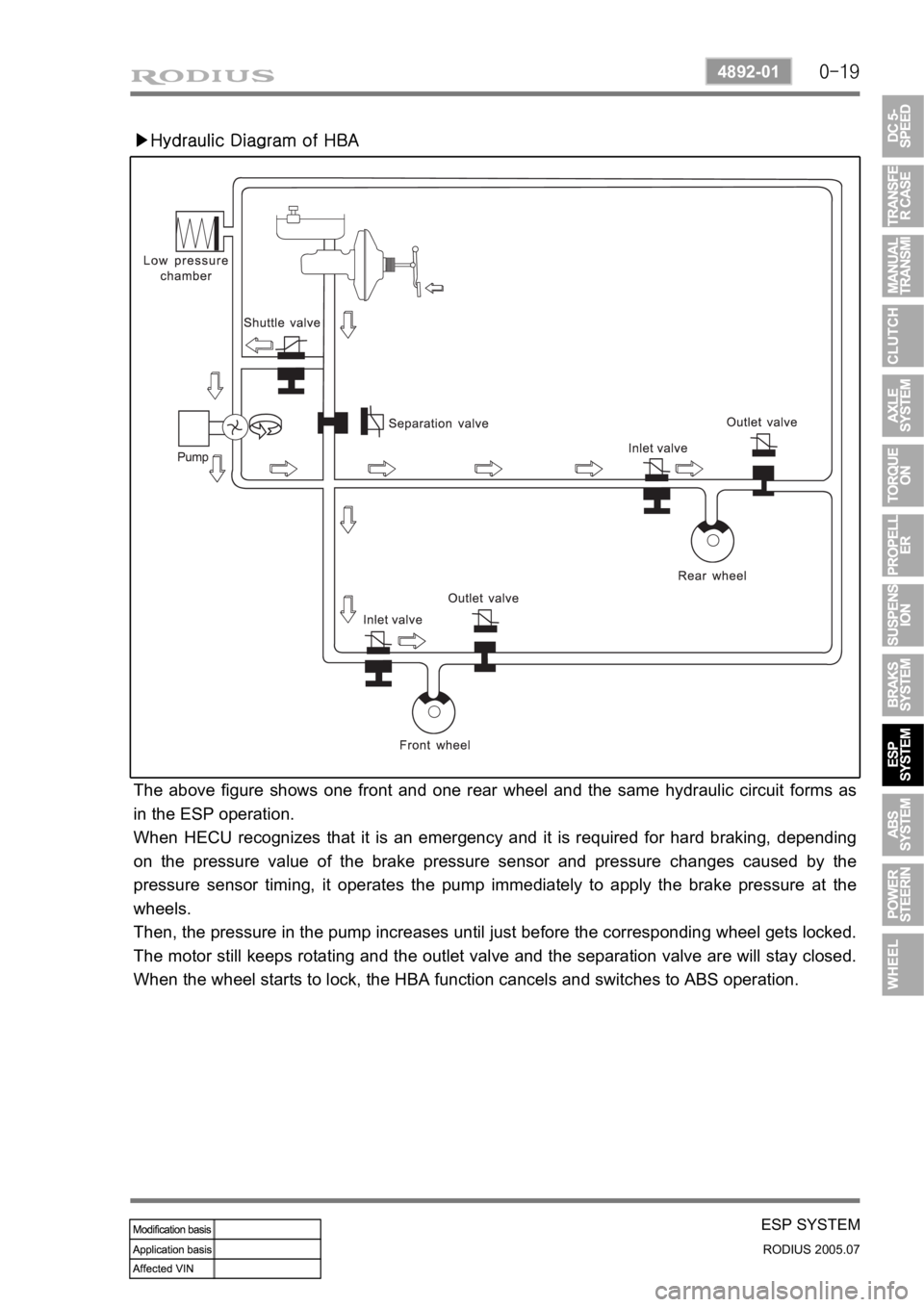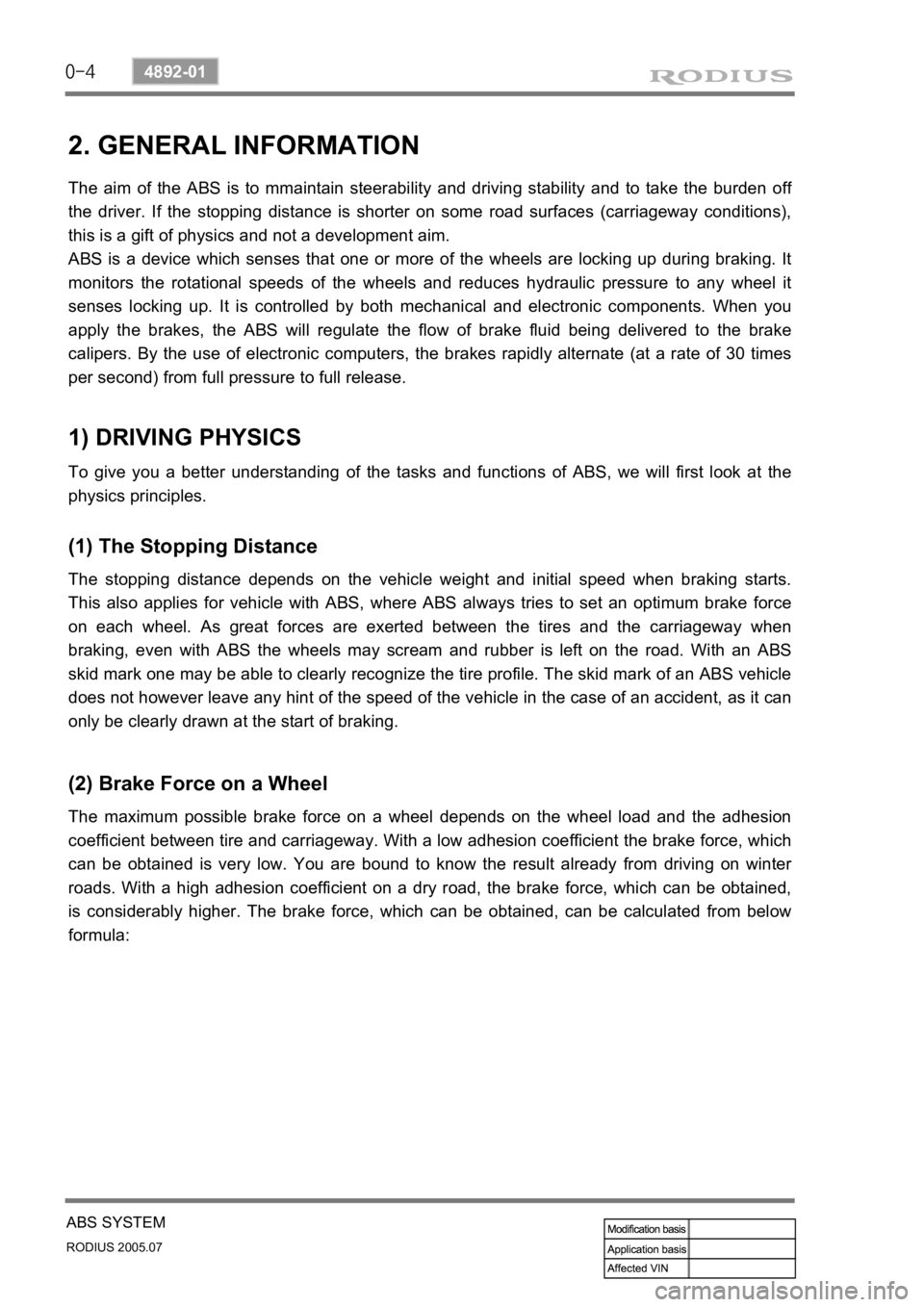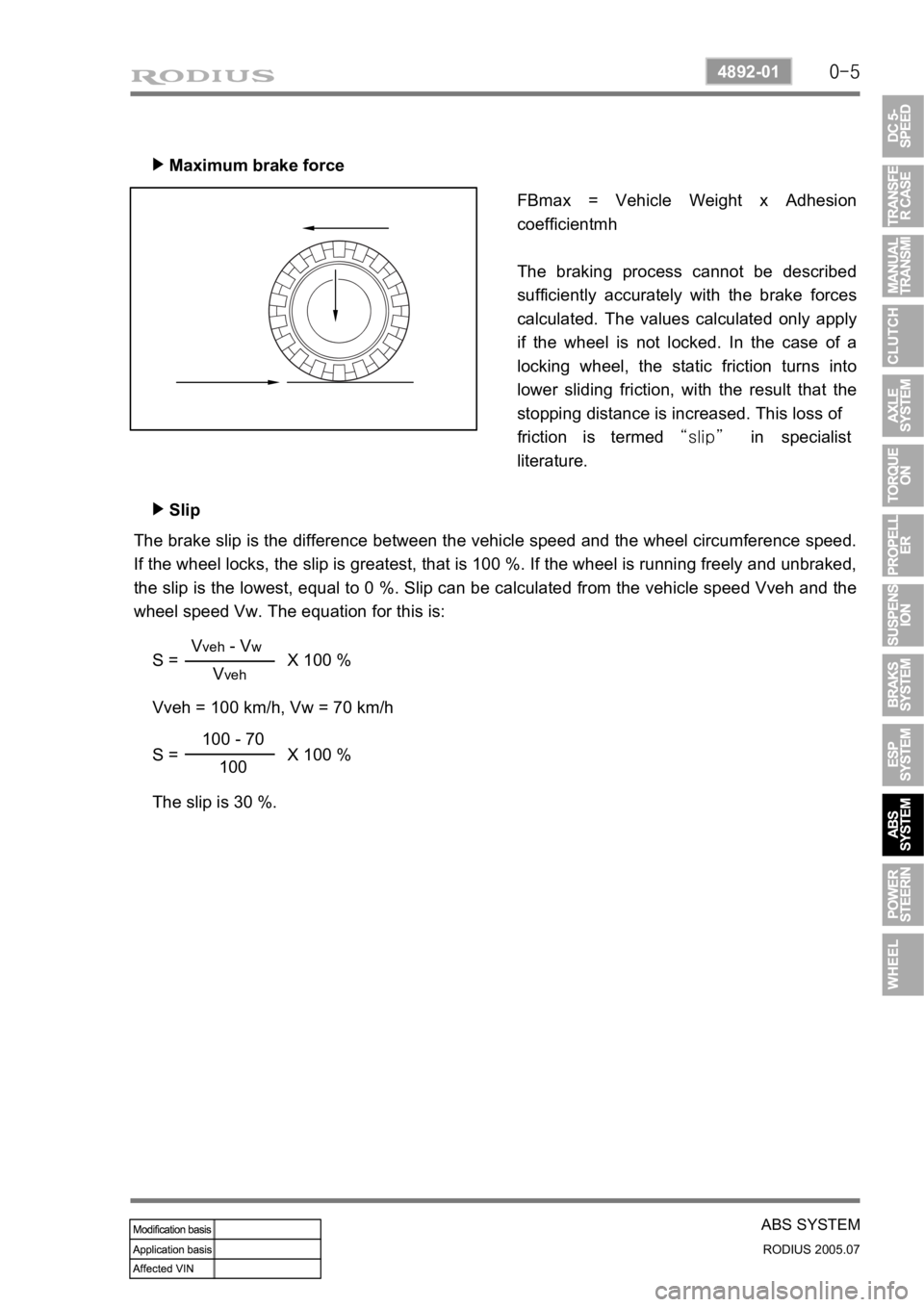SSANGYONG RODIUS 2005 Service Manual
Manufacturer: SSANGYONG, Model Year: 2005, Model line: RODIUS, Model: SSANGYONG RODIUS 2005Pages: 502, PDF Size: 70.43 MB
Page 251 of 502

0-18
RODIUS 2005.07
4892-01
ESP SYSTEM
▶When applied ABS (increased pressure)
The shuttle valve and inlet valve will be open and the separation valve and outlet valve will be
closed. Then, the pump is operated.
When ESP operates while the ABS is operating, the pressure will be increased continuously
until just before the corresponding wheel gets locked.
Page 252 of 502

0-19
ESP SYSTEM
RODIUS 2005.07
4892-01
▶Hydraulic Diagram of HBA
The above figure shows one front and one rear wheel and the same hydraulic circuit forms as
in the ESP operation.
When HECU recognizes that it is an emergency and it is required for hard braking, depending
on the pressure value of the brake pressure sensor and pressure changes caused by the
pressure sensor timing, it operates the pump immediately to apply the brake pressure at the
wheels.
Then, the pressure in the pump increases until just before the corresponding wheel gets locked.
The motor still keeps rotating and the outlet valve and the separation valve are will stay closed.
When the wheel starts to lock, the HBA function cancels and switches to ABS operation.
Page 253 of 502

0-20
RODIUS 2005.07
4892-01
ESP SYSTEM
4. ELECTRICAL CIRCUIT DIAGRAM
<0d96007e008f008c008c00930047007a0097008c008c008b0047007a008c0095009a0096009900530047007a009b009600970047007300880094009700530047006b00900088008e00950096009a0090009a00530047007e008800990095009c0095008e00
4700730088009400970047004f00680069007a0056006c007a>P)
Page 254 of 502

0-21
ESP SYSTEM
RODIUS 2005.07
4892-01
<0d960069009900880092008c004700770099008c009a009a009c0099008c0047007a008c0095009a0096009900530047006c007a00770047007a008c0095009a0096009900530047007a008c0095009a009600990047006a0093009c009a009b008c009900
530047006c007a007700470076006d006d0047007a009e0090>tch
Page 255 of 502

0-3
ABS SYSTEM
RODIUS 2005.07
4892-01
4892-01ABS
1. SPECIAL TOOLS AND EQUIPMENT
Page 256 of 502

0-4
RODIUS 2005.07
4892-01
ABS SYSTEM
2. GENERAL INFORMATION
The aim of the ABS is to mmaintain steerability and driving stability and to take the burden off
the driver. If the stopping distance is shorter on some road surfaces (carriageway conditions),
this is a gift of physics and not a development aim.
ABS is a device which senses that one or more of the wheels are locking up during braking. It
monitors the rotational speeds of the wheels and reduces hydraulic pressure to any wheel it
senses locking up. It is controlled by both mechanical and electronic components. When you
apply the brakes, the ABS will regulate the flow of brake fluid being delivered to the brake
calipers. By the use of electronic computers, the brakes rapidly alternate (at a rate of 30 times
per second) from full pressure to full release.
1) DRIVING PHYSICS
To give you a better understanding of the tasks and functions of ABS, we will first look at the
physics principles.
(1) The Stopping Distance
The stopping distance depends on the vehicle weight and initial speed when braking starts.
This also applies for vehicle with ABS, where ABS always tries to set an optimum brake force
on each wheel. As great forces are exerted between the tires and the carriageway when
braking, even with ABS the wheels may scream and rubber is left on the road. With an
ABS
skid mark one may be able to clearly recognize the tire profile. The skid mark of an ABS vehicle
does not however leave any hint of the speed of the vehicle in the case of an accident, as it can
only be clearly drawn at the start of braking.
(2) Brake Force on a Wheel
The maximum possible brake force on a wheel depends on the wheel load and the adhesion
coefficient between tire and carriageway. With a low adhesion coefficient the brake force, which
can be obtained is very low. You are bound to know the result already from driving on winte
r
roads. With a high adhesion coefficient on a dry road, the brake force, which can be obtained,
is considerably higher. The brake force, which can be obtained, can be calculated from below
formula:
Page 257 of 502

0-5
ABS SYSTEM
RODIUS 2005.07
4892-01
Maximum brake force ▶
FBmax = Vehicle Weight x Adhesion
coefficientmh
The braking process cannot be described
sufficiently accurately with the brake forces
calculated. The values calculated only apply
if the wheel is not locked. In the case of a
locking wheel, the static friction turns into
lower sliding friction, with the result that the
stopping distance is increased. This loss of
friction is termed “slip” in specialist
literature.
Slip ▶
The brake slip is the difference between the vehicle speed and the wheel circumference speed.
If the wheel locks, the slip is greatest, that is 100 %. If the wheel is running freely and unbraked,
the slip is the lowest, equal to 0 %. Slip can be calculated from the vehicle speed Vveh and the
wheel speed Vw. The equation for this is:
S = X 100 %
Vveh = 100 km/h, Vw = 70 km/h
S = X 100 %
The slip is 30 %.
Vveh - Vw
Vveh
100 - 70
100
Page 258 of 502

0-6
RODIUS 2005.07
4892-01
ABS SYSTEM
Typical slip curves ▶
For the various carriageway conditions the
adhesion coefficients were plotted. The
typical course of the curves is always the
same. The only special feature is shown by
the curve for freshly fallen snow, for this
curve increases at 100 % slip. In a vehicle
without ABS, the wheel locks on braking and
therefore pushes a wedge before it. This
wedge of loose surface or freshly fallen
snow means and increased resistance and
as a result the stopping distance is shorter.
This reduction in stopping distance is not
possible with a vehicle with ABS, as the
wheel does not lock. On these surfaces the
stopping distance with ABS is longer than
without ABS. The reason for this is based in
physics and not in the Anti-Lock System.
However, as mentioned before, ABS is not
about the stopping distance, but
maneuverability and driving stability, for with
ABS you can steer round an obstacle.
A
device with locking wheels without ABS
cannot be steered. So what use then is the
shorter stopping distance if the vehicle has
already hit the car in front, because you did
not have a chance to steer round the
obstacle?
Page 259 of 502

0-7
ABS SYSTEM
RODIUS 2005.07
4892-01
Kamm circle ▶
Before we go into the Kamm circle, you
should know that a tire offers a maximum o
f
100 % transmissibility. It is all the same fo
r
the tire whether we require 100 % in the
direction of braking or in the direction of the
acting lateral force, e.g. when driving round
curves. If we drive into a curve too fast and
the tire requires 100 % transmissibility as
cornering force, the tire cannot transmit any
additional brake force. In spite of the ABS
the car is carried out of the curve. The
relationship between brake force B and
cornering force S is shown very clearly in
the Kamm circle. If we put a vehicle wheel in
this circle, the relationship becomes even
clearer. In this relationship: as long as the
acting forces and the resulting force remain
within the circle, the vehicle is stable to
drive. If a force exceeds the circle, the
vehicle leaves the road.
Page 260 of 502

0-8
RODIUS 2005.07
4892-01
ABS SYSTEM
Brake force
When depressing the brake pedal the
brake force increases to the maximum,
then the brake force decreases until the
wheel locks.
Cornering force
The cornering force is a maximum when
the wheel is turning freely with zero slip.
When braking the cornering force falls to
zero if the wheel locks (slip 100 %).
ABS operating range
The operating range starts just before the
maximum brake force and ends in
maximum, for the unstable range then
begins, in which no further modulation is
possible. The ABS controls the regulation
of the brake pressure so that the brake
force only becomes great enough for a
sufficient proportion of cornering force to
remain. With ABS we remain in the
Kamm circle as long as the car is driving
sensibly. We will leave driving physics
with these statements and turn to the
braking systems with and without ABS. -
-
- Brake and cornering force ▶